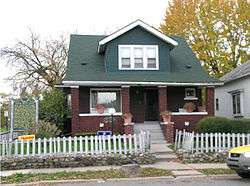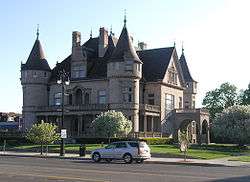Ossian H. Sweet House
|
Ossian H. Sweet House | |
 | |
 | |
| Location |
2905 Garland Street Detroit, Michigan |
|---|---|
| Coordinates | 42°22′13″N 82°59′3″W / 42.37028°N 82.98417°WCoordinates: 42°22′13″N 82°59′3″W / 42.37028°N 82.98417°W |
| Built | 1919 |
| Architect | Maurice Finkel |
| Architectural style | American Craftsman bungalow |
| NRHP reference # | 85000696[1] |
| Significant dates | |
| Added to NRHP | April 04, 1985 |
| Designated MSHS | November 21, 1975[2] |
The Ossian H. Sweet House is a privately owned house located at 2905 Garland Street in Detroit, Michigan. The house was designed by Maurice Herman Finkel, and in 1925 it was bought by its second owner, physician Ossian Sweet, an African American. Soon after he moved in, the house was the site of a confrontation when a white mob of about 1,000 gathered in protest of the Sweet family moving into the formerly all-white neighborhood. Rocks thrown by the mob broke windows, and someone in the house fired out at the mob, killing one man and wounding another. Sweet and ten other persons from the house were arrested for murder.
Contacted by the NAACP, nationally known attorney Clarence Darrow joined their defense team. After a mistrial, in the second trial the first defendant was acquitted. The prosecution dropped charges against the remaining defendants. The case was considered important as part of the civil rights movement and establishing freedom of residence. The house was designated as a Michigan State Historic Site in 1975[2] and listed on the National Register of Historic Places in 1985.[1]
Ossian Sweet
Ossian Sweet was born in Florida and earned a medical degree from Howard University.[3] He practiced medicine briefly in Detroit, then continued his medical studies in Vienna and Paris before returning to Detroit in 1924 to accept a position at Dunbar Hospital.[3] He began saving money for a home, and by the spring of the next year had saved $3500. Sweet used the $3500 as a down payment on a $18,500 house located on Garland Street in east Detroit.[3]
The Ossian Sweet House
The house Sweet purchased is a 1½-story brick house,[4] built in 1919,[5] and is typical of many homes in working-class Detroit neighborhoods.[6] It is a bungalow-style structure with a full basement, an open porch on the first floor, and an enclosed sun porch on the south side.[2] The second story is covered with brown shingling, and atop the house is a simple gable roof with a central dormer.[2] The house is enclosed by an unpainted silver aluminum fence.
The house is located on the corner of Garland and Charlevoix, in what was at the time an all-white neighborhood.[3] Sweet chose a home in an all-white neighborhood because housing options in black neighborhoods were in general older and substandard,[5] and he wanted better accommodations for his wife and daughter.[3]
September 1925
Ossian Sweet and his wife, Gladys, moved into the house on September 8, 1925.[3] A group of neighbors in the community, aware of Sweet's imminent arrival, had vowed to keep blacks out of the neighborhood, saying that they intended to maintain "the present high standards of the neighborhood."[4] Sweet knew of the neighbors' antipathy (telling his brother that he was "prepared to die like a man"), and arranged for some friends and relatives to stay with him for a few days.[3] He also brought along guns and ammunition. There had been attacks against blacks in other neighborhoods.
The neighborhood was tense, and groups of people gathered outside Sweet's home. The Detroit Police, sensing a grave situation, posted officers at the scene day and night.[3] The following day, September 9, Sweet and his friends went to work. When they returned, the crowd had grown into a mob, throwing rocks and bottles.[4] A Detroit News reporter, Philip A. Adler, later testified that the mob consisted of "400 and 500" people, throwing stones that hit the house "like hail."[3] This lasted until around 10pm, when shots rang out from the second-floor window,[5] killing a man on a porch and wounding another in the crowd. The police arrested all the occupants of the house, charging each with murder.[3]
Aftermath
The NAACP promised to help the defense, and brought in Clarence Darrow as chief counsel.[3] He was assisted by Arthur Garfield Hays and Walter M. Nelson. Frank Murphy was the presiding judge.[3] The jury consisted of twelve white men. Despite this, Darrow built an impressive case arguing self-defense, and the case ended in a hung jury. The prosecution decided to try the defendants individually the second time, and started with Ossian's brother Henry, but he was acquitted. Believing it could not gain convictions, the prosecution dropped charges against Ossian Sweet and remaining defendants.[3]
After the trials, Ossian Sweet rented the home on Garland to a white couple until 1930, when he moved back into the house.[5] However, both his wife and two-year-old daughter Iva had died of tuberculosis in 1926.[3] Sweet remarried twice, and divorced each time.[3] In 1946, he sold the house, moving into the flat above a pharmacy he owned. In 1960, in failing health, Sweet took his own life.[3]
A state of Michigan historical marker stands in front of the house at 2905 Garland.[7]
See also
References
- 1 2 National Park Service (2008-04-15). "National Register Information System". National Register of Historic Places. National Park Service.
- 1 2 3 4 Sweet, Ossian H., House from the state of Michigan
- 1 2 3 4 5 6 7 8 9 10 11 12 13 14 15 16 Patricia Zacharias, "'I have to die a man or live a coward' -- the saga of Dr. Ossian Sweet", The Detroit News, 12 February 2001
- 1 2 3 Ossian Sweet House from the National Park Service
- 1 2 3 4 Home of Dr. Ossian Sweet from Detroit1701.org
- ↑ Eric J. Hill, John Gallagher, American Institute of Architects Detroit Chapter, AIA Detroit, Wayne State University Press, 2002, ISBN 0-8143-3120-3, p. 282
- ↑ Dr. Ossian Sweet/Home from michmarkers.com


